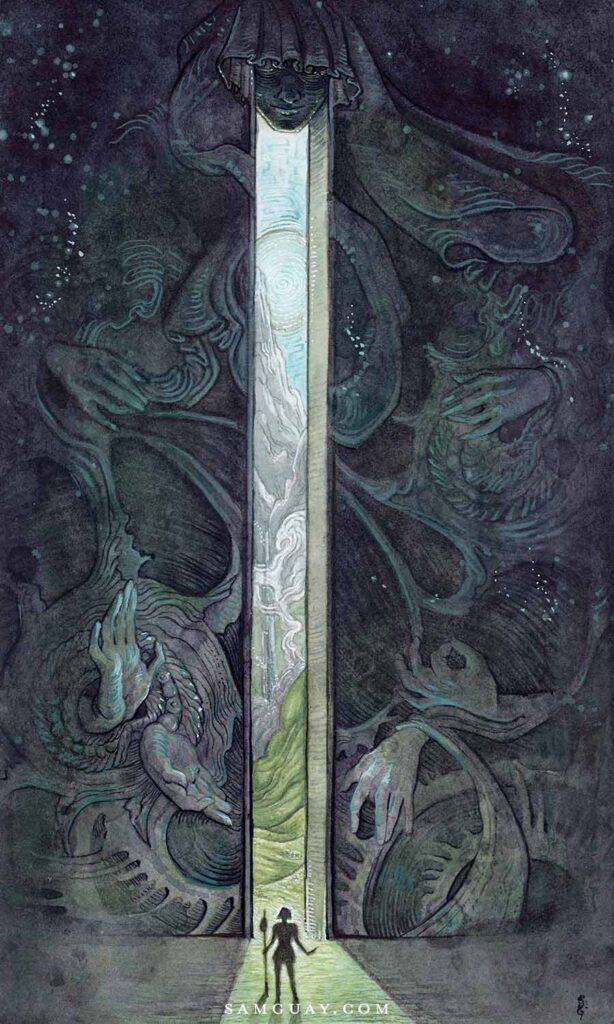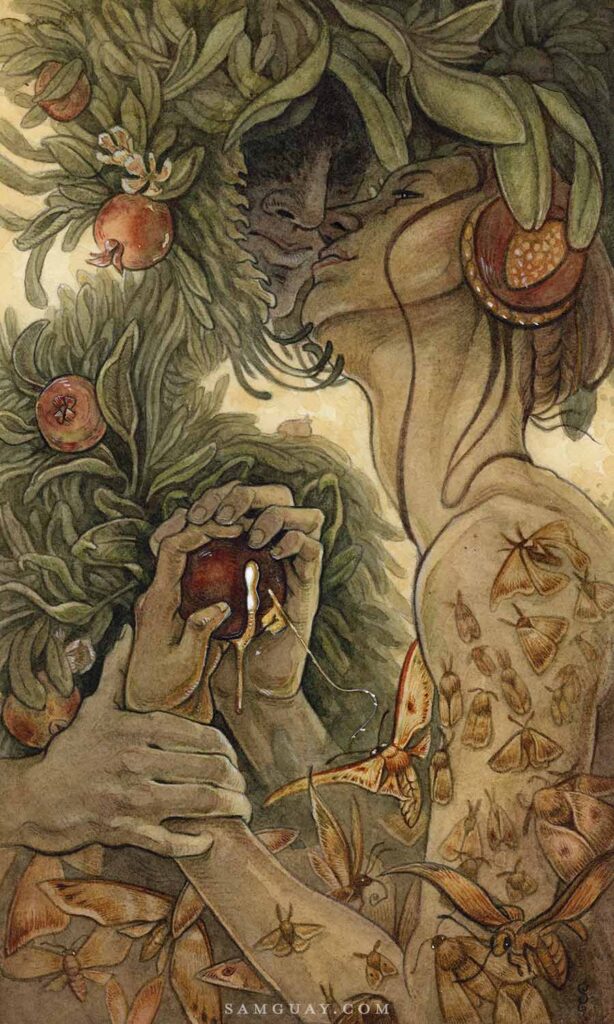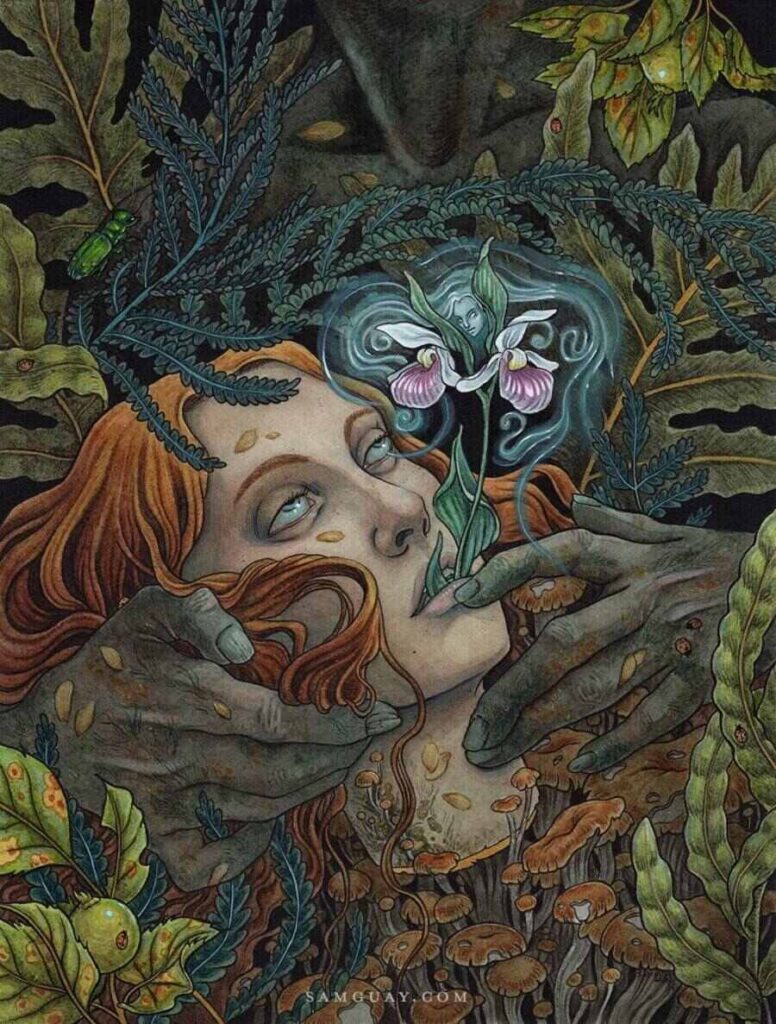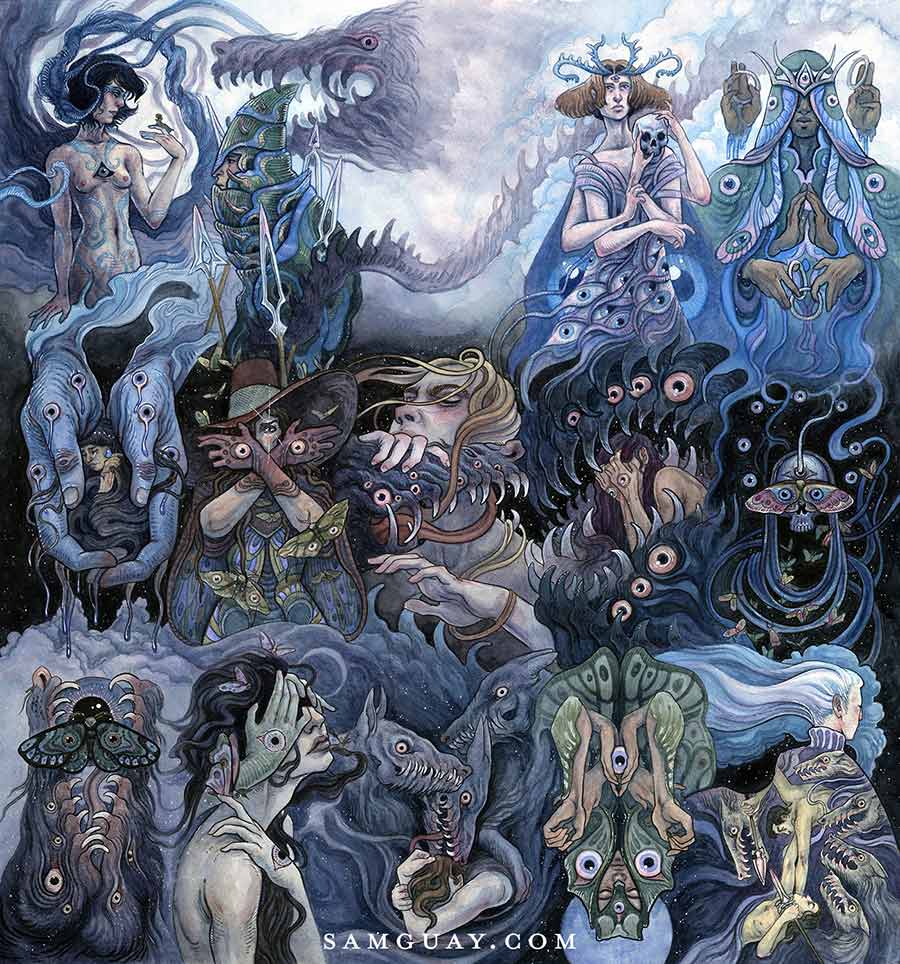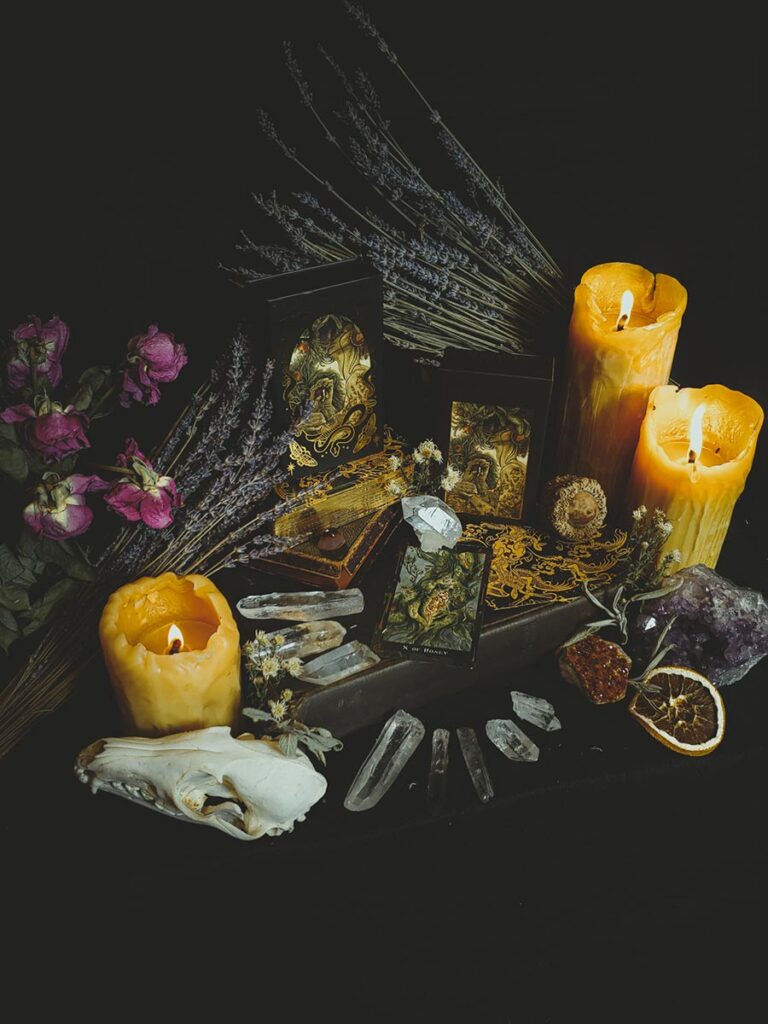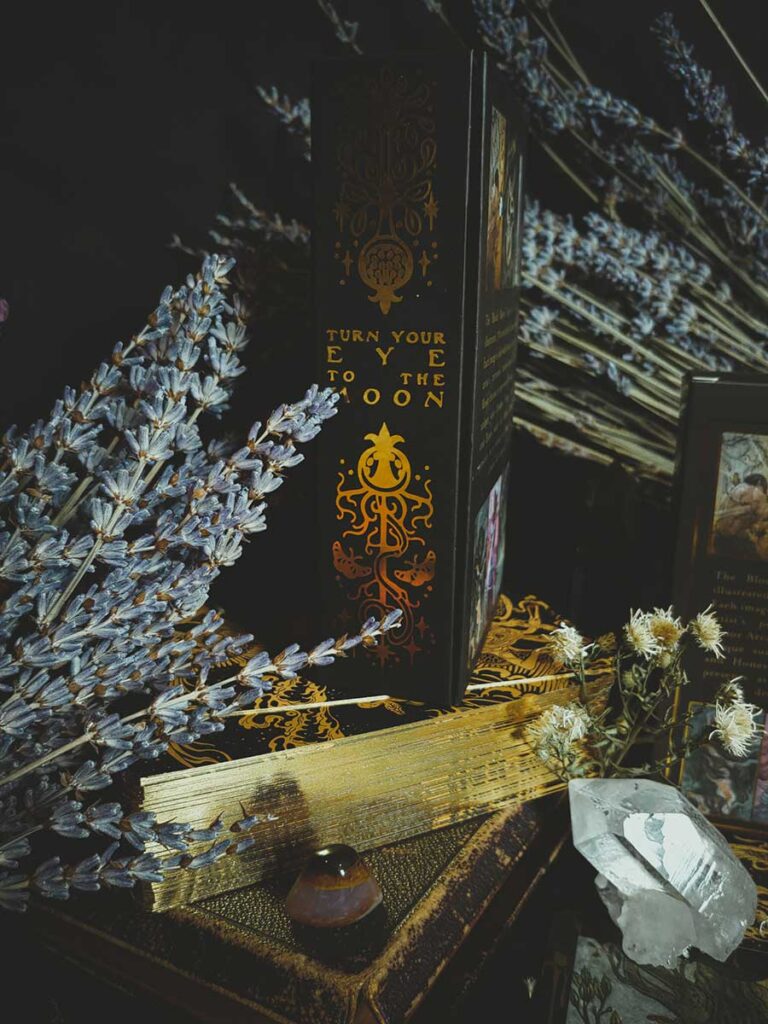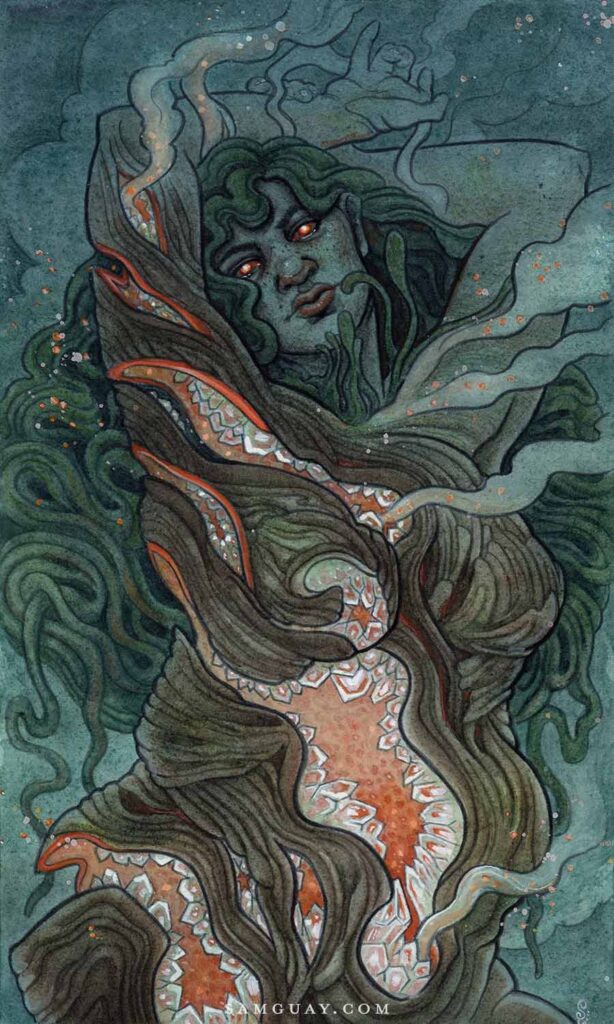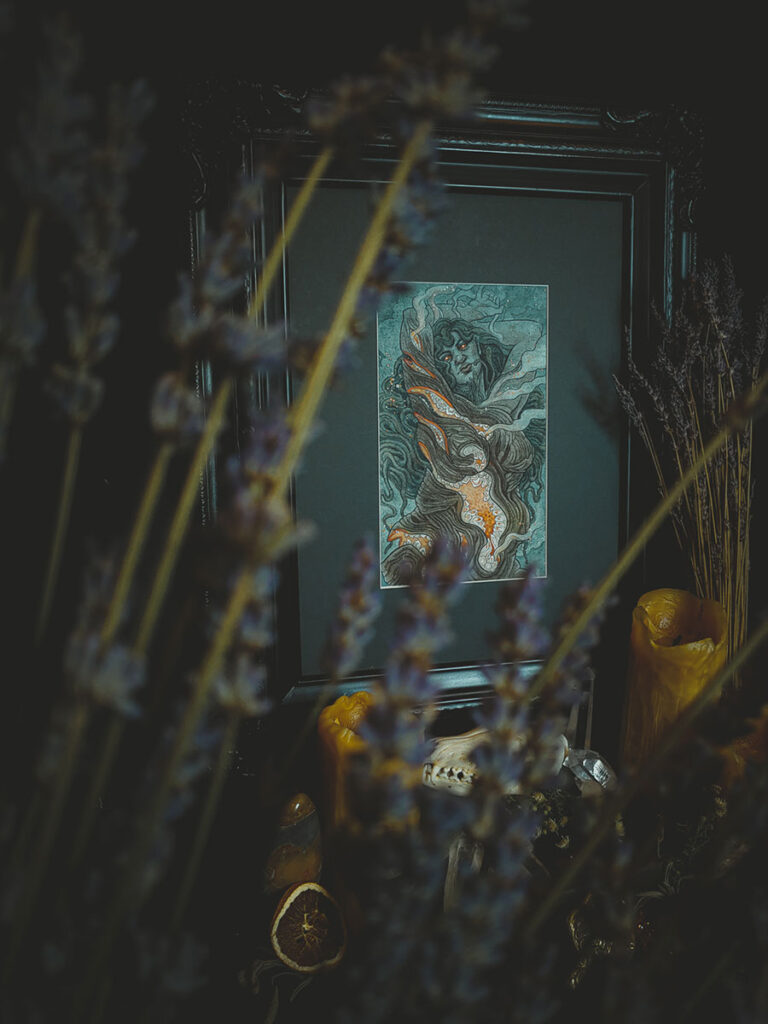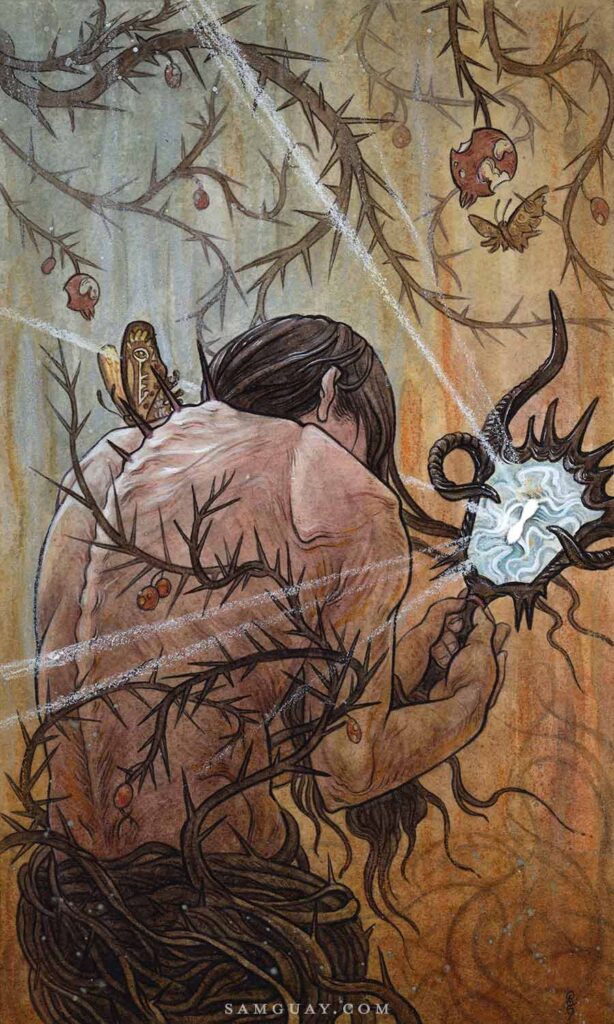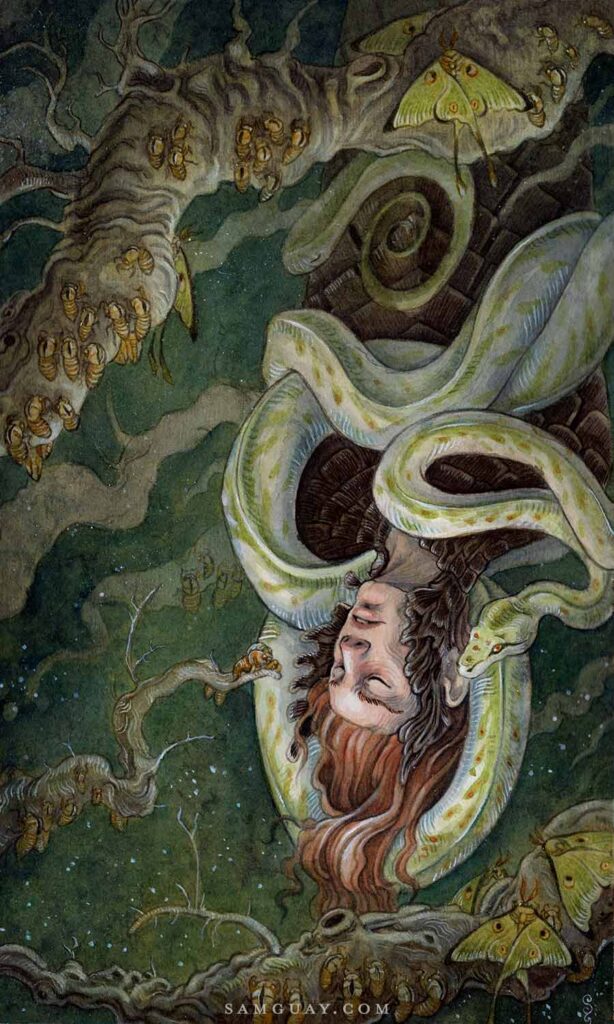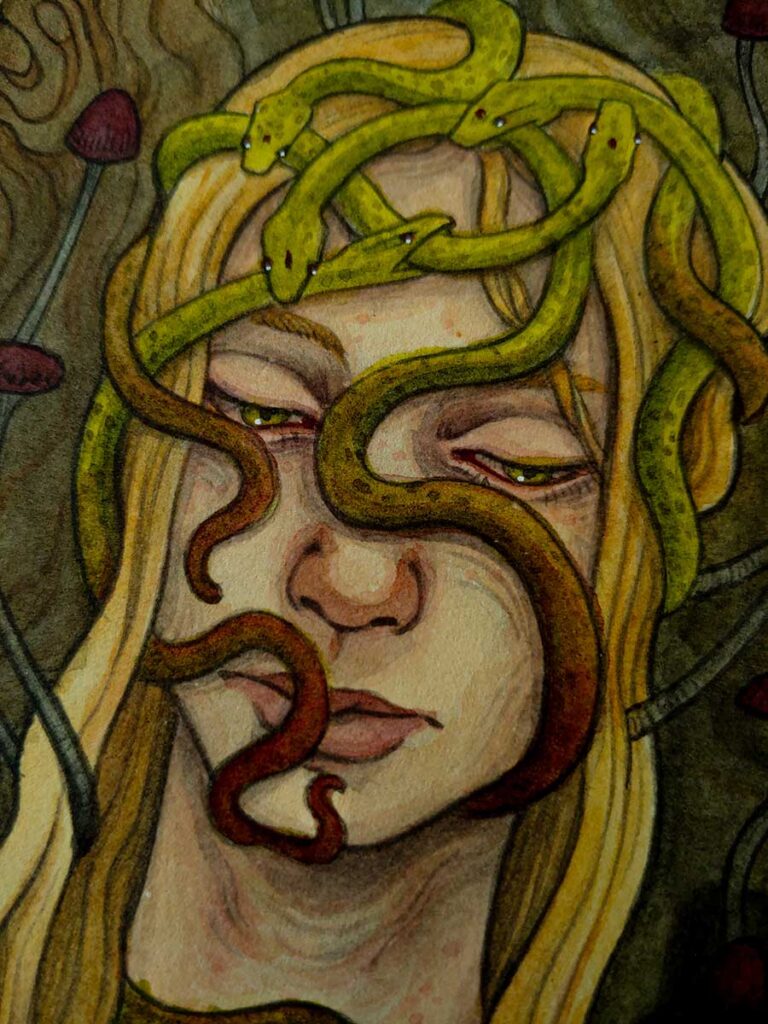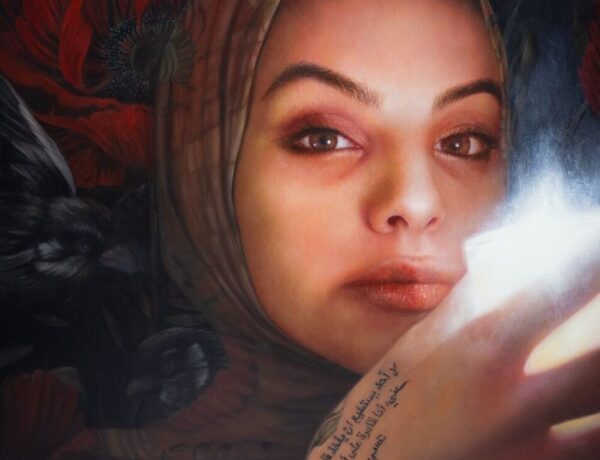The opulent colors and textures of Sam Guay’s Blood Moon Tarot invite art lovers to look into a magic mirror and see their questions reflected through a mystic lens. Poignant watercolor motifs present a range of subjects and emotions. Familiar archetypes like The Lovers, The Fool, and The Hanged Man encourage contemplation. A cornucopia of decadently layered symbols invite wonderstruck eyes to ponder their meaning. With four original suits representing the minor arcana in Guay’s own visionary imagery, The Blood Moon Tarot is a fascinating work of artistry born in the form of a divining tool.
While tarot cards first appear in the historical record in 15th century Europe, their use as a divination tool didn’t become popular until the 18th century. Since that time, untold numbers of artists have put their personal stamp on the cards, often using symbolism unique to their own region or culture. In this way, The Blood Moon Tarot joins a centuries long lineage of mystic artistry by representing ideas as old as humanity with imagery pulled straight from Guay’s own surroundings.
A veteran of Haven Gallery, Guay’s work has been featured in a number of exhibitions as well as publications including Strange Horizons Magazine, The Cafe Review, Nightmare Magazine, and Maine Magazine. Their client list also includes Magic: The Gathering and ImagineFX–but The Blood Moon Tarot is perhaps Guay’s most personal work to date. With compositions inspired by their upbringing and surroundings in rural New England, each card in the deck of 78 is a piece of Guay’s personal history.
Like layers of detritus draped across the floor of an old growth forest, the mesmerizing cards draw in viewers with an abundance of texture. A signature of Guay’s personal style of watercolor imagery, the complex textures are inspired by the natural world. Every glance exposes new details bursting with abstraction. From the high contrasts between earthy greens and exuberant yellows in the suit of Honey to surrealist greys and ethereal blues in the suit of Dreams, Guay’s personal take on this ancient divination technique is a feast for the senses. In this exclusive interview, we dive deep into Guay’s creation process to learn how they brought The Blood Moon Tarot to life and what inspiration they look forward to fleshing out in the future.
Creating a brand new tarot deck of 78 cards is an enormous task. What led you toward this body of work?
At 13 or 14 I received my first tarot deck and I loved that it was a functional piece of art, a creative tool, and something that felt inherently magical. It wasn’t the association with magic or the occult that made it feel special, it was an invitation to interact with art and imagery on such an intimate level. I continued to use tarot cards through the years and always wanted to make a deck that was personal to me.
What inspired the four suits—Songs, Skins, Dreams, and Honey?
In the winter of 2016 I was lucky enough to have a weekend trip to New York completely upended by a massive snowstorm (yes, lucky). All the shows I planned to attend were canceled, but I serendipitously stumbled upon an exhibition at the Cloisters featuring medieval playing cards, including some gorgeous original tarot decks. Many of the decks featured unique suits: bells, acorns, rope, and such. Sometimes the suits were chosen to represent the family commissioning the cards, and that encouraged me to make the suits my own. Swords became Dreams, Cups became Songs, Wands became Skins, and Pentacles became Honey. Each has specific symbols with personal meaning. For example, Dreams represents our mind and thoughts so the suit explores struggles with anxiety, something that I have had a lot of experience with. The nightmarish hound creatures that appear in those cards are from a series of sleep paralysis episodes I had at one of my lowest points in dealing with panic disorder. Though some might find those creatures disturbing, their appearances in my dreams helped me recover from anxiety that had made it impossible for me to function.
The nightmarish hound creatures that appear in those cards are from a series of sleep paralysis episodes I had at one of my lowest points in dealing with panic disorder. Though some might find those creatures disturbing, their appearances in my dreams helped me recover from anxiety that had made it impossible for me to function.
What are some challenges you experienced during the four years you spent creating the imagery for The Blood Moon Tarot? Are there any sources of encouragement or inspiration you looked to during those moments?
The biggest challenge I had was after the success of the Kickstarter. I still had about half of the paintings to complete but, with the looming pressure and expectations of hundreds of people who funded the project, I experienced creative paralysis for the first time. I was stuck in a cycle of procrastination (putting off work because I was worried it wouldn’t meet the approval of my backers) followed by guilt, shame, and self-deprecation. I couldn’t work for months. Eventually I was able to see a therapist who helped me get back into healthy working habits and a mindset focused on making myself happy with my work, instead of fearing that I wouldn’t make others happy.
What is your process for creating a piece from start to finish?
The specifics of painting aren’t always consistent. First I need an idea. To get one usually takes a lot of reading, listening to music, walking, weird dreams, journaling, and 6 AM half-awake shower thoughts. Ideas tend to pop up all over the place, but finding the right ones take a little extra work. From there I plan. I make a sketch, turn it into a more fleshed out drawing, do color studies, and then I paint. Painting itself seems to go through a blissful beginning stage where everything feels awesome, a very long ugly stage where it feels like everything is ruined (I’ve learned to just work thought this), and then in the last 10% there’s more looking at the piece than painting and it’s only in the last final touches that I feel good about a piece again. It’s always a ride, and I have to say the ideation phase and sketching are probably my favorite.
How has the relatively rural setting of your home in New England affected your creative process? Do you see differences in the work you create in isolation versus more communal settings?
Two years ago I moved from the small, rural New Hampshire town where I grew up to a popular tourist town in Massachusetts. I miss the woods so much. I miss the solitude, I miss all the little bugs, and the mist, and the wild apple trees. But my new home gives me independence that I didn’t have before, and it’s had a significantly positive impact on my overall happiness. I’ll always feel most at home with nature, and I think it’s hard to untangle myself and my work from that regardless of where I am living. Even though I’m in an urban area I walk to the ocean regularly and have built a bucket garden on my little porch which hosts many lovely insect visitors. I still have my ways to commune with nature and feed that inspiration here. That said, when it comes to working I struggle to stay focused in communal studio set ups (I always want to see what other people are doing and talk to them about art and ideas). On the occasions that I’ve attended workshops or classes, I do my best but nothing sinks in until I’ve had time alone back in my own studio.
I’ll always feel most at home with nature, and I think it’s hard to untangle myself and my work from that regardless of where I am living.
You’ve cited journaling as an important part of your creative process. What do you enjoy about journaling and what advice would you give to artists who are just beginning a journaling practice?
Journaling is one of my many creative outlets, and sometimes it feels more like my sketchbook than my actual sketchbook does. My paintings begin as ephemeral feelings or abstract ideas and are often about exploring inner worlds. Delving deeply into those inner realms feels the most safe and unhindered in my journal. Writing allows me to gain a better understanding of my ideas and helps ground them into a tangible enough form to work with.
If you’re just beginning a journaling practice my best advice is to write something, anything, for at least 15 minutes each day. There’s no pressure to share what you write, or make it beautiful, so try to let go of self-censoring.
You’ve also cited sensory deprivation tanks as a place of inspiration. What is that experience like?
It’s like floating completely alone in the middle of the ocean on a silent, dark night. This might not be for everyone, but for me it’s heaven. The other great thing about the experience is that the lack of sensory input creates an environment for a very bored brain. Bored brains get very weird and creative. I’ve had some bizarre experiences in sensory deprivation tanks, like having the sensation that I was a bunch of tiny noodles or strings, or that the sensation of seeing was a heavy, physical thing—like milk pouring into my open eyes.
A signature of your work is the beautifully textural quality of your pieces. Are those inspired by specific textures in nature? What techniques do you use to create texture in your work?
They’re definitely inspired by nature, but I also just love texture. Whenever I see textures and colors I want to eat them, they look delicious. Previously my textures were done with layers of paint and tiny little brushstrokes. In my more recent work I draw a lot of crusty, lichen-inspired textures and those are all done by hand instead of relying on the granulation of the paint to provide texture.
Your Kickstarter campaign to raise funds for printing The Blood Moon Tarot was an enormous success, raising over five times your original goal amount. What did it feel like to know that so many people connected so powerfully with your work? Have you learned anything through the Kickstarter process?
I was completely blown away, but it didn’t feel entirely real or complete until recently. Seeing people using my cards and bringing their own ideas to my work brings me a lot of joy and a strong sense of accomplishment. I have learned so much through the Kickstarter process I could write you a whole novel. So many things didn’t go according to plan—plus the pandemic added an extra layer of challenges to contend with and left me to handle it on my own. I made it happen though, and I feel so much more prepared for future projects of this magnitude.
How do you hope your work will affect viewers?
I’m happy to let the Blood Moon Tarot go out into the world and continue to grow and evolve in the hands of other people in whatever way they choose. My biggest hope is that it inspires people to use their own experiences and their own voices to make their own unique work.
Aside from The Blood Moon Tarot, what are some other projects that have stretched your skills and inspired you?
The Blood Moon Tarot is my first big project, so I don’t have any of my own work to compare it to. But freelance work can be very challenging, bring me way out of my comfort zone, and I think that’s a great thing to do to keep my creativity fresh. Last year I did a movie poster for an indie movie (I don’t think I can share more right now) that was made by just a few people doing something they loved—those sorts of projects are my absolute favorite and make me buzz with inspiration. When people are doing something that excites them and aren’t self-censoring their creativity over fear of how they’ll be perceived, that is a joy to witness and an even bigger joy to be a part of.
What are you looking forward to creating in the future?
Right now I’m looking forward to painting. I have a stack of drawings from the past few years that I haven’t had time for and I want to make them happen. I have plans for a few more projects, the next of which is a little book on using tarot for dream interpretation. I had it all written up a few years ago but recently decided to go back in and reimagine it more in the phantasmagoric spirit of dreams.


